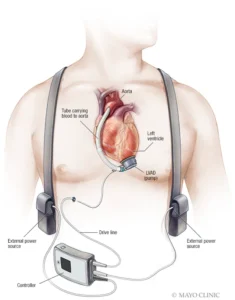How it works
-
- The LVAD is attached to the heart’s left ventricle and the aorta.
- The LVAD pumps blood from the left ventricle to the rest of the body.
- The LVAD is connected to a controller outside of the body.
- The LVAD is attached to the heart’s left ventricle and the aorta.
- The controller runs the pump and provides messages to help operate the system.
- The LVAD needs to be connected to a power source, either batteries or an electrical outlet.
When it’s used
- LVADs can be used as a long-term treatment for heart failure, known as “destination therapy”.
- LVADs can also be used temporarily until a heart transplant becomes an option, known as “bridge-to-transplant therapy”.
Risks
- LVADs require open heart surgery.
- There’s an increased risk of blood clots, stroke, kidney failure, infection, bleeding, and pump malfunction.
Benefits
- LVADs can help reduce symptoms and improve quality of life.
- LVADs can help people return to normal activities, such as driving, working, and going on holiday.

